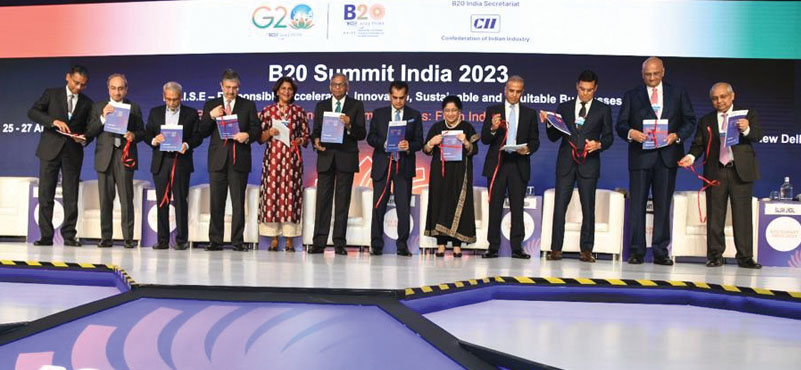Five transformative strategies that the Budget 2023 has taken note of based on trends that will shape India
The Indian economy is poised to become the third largest economy in the world by the end of the decade. Going ahead, five key trends are likely to shape the coming decade. First, India is set to see over 50 crores more people living in urban areas by 2050. Second, data from the National Family and Health Survey (NFHS) shows that for the first time, there are more women than men in India. This is occurring amidst our demographic dividend. Third, digitalisation has picked up pace across the world. Fourth, the decarbonisation imperative still needs acceleration. Finally, owing to rising geopolitical and trade tensions, we are seeing an increasing trend towards deglobalisation. India is well placed to take advantage of this global churn. In an aging world, India is amongst the youngest. With robust digital public infrastructure, we are poised to capitalise on the digitalisation opportunity. In a world with disrupted supply chains and trade tensions, India is looking outward. With many countries facing many challenges in decarbonisation, India has emerged as the most important country in the battle against climate change. The Budget has taken cognisance of these trends shaping India and unveiled transformative strategies. Firstly, urbanisation. The benefits offered by cities in terms of agglomeration and aggregation are well known. Between now and 2050, it is estimated that another 500 million more people in India will be living in urban areas. Without sustainable urbanisation, cities are likely to fall prey to congestion and pollution, rather than bringing the agglomeration benefits. The cities of the future must be designed around the principles of transit-oriented development, with public transport at their core. Urban planning must include elements such as bus rapid transit, light rapid transit, mass rapid transit and non-motorized transit systems. Relooking floor space index (FSI) norms will enable vertical, rather than horizontal growth of our cities. Principles of circular economy, for instance, to address water supply, must also be a crucial for the new urbanisation model. Urbanisation will have to be a key driver of India’s growth in the coming years. Recognising this, the Budget introduced the Urban Infrastructure Development Fund, with Rs. 10,000 crores annually.
 Secondly, continued focus on building infrastructure through expanding capex is imperative. For the second successive year, the Budget has raised capital expenditure by 33%, bringing it to Rs. 10 lakh crores. The infrastructure being built will connect people and markets and reduce the cost of logistics. Going ahead, the focus may be on unlocking investments through PPP mode and asset monetisation. Investments in infrastructure through PPP have slowed down, and this is an apt time to rejuvenate PPPs. Asset monetisation carries with it the benefit of unlocking the latent potential of public infrastructure, bringing in efficiencies in operations. This will create a virtuous cycle of ‘crowding-in’ private expenditure and investments. With global value chains being realigned, investing in infrastructure will make India an attractive option for global manufacturing. Reviving animal spirits of the private sector will be critical for long term sustained growth. Continuing to work on next-generation reforms and ease of doing business at the state level are the next avenues we must pursue. Again, the Budget delivers on this front through making PAN cards as universal identifiers, a unified filing process and an entity DigiLocker.
Secondly, continued focus on building infrastructure through expanding capex is imperative. For the second successive year, the Budget has raised capital expenditure by 33%, bringing it to Rs. 10 lakh crores. The infrastructure being built will connect people and markets and reduce the cost of logistics. Going ahead, the focus may be on unlocking investments through PPP mode and asset monetisation. Investments in infrastructure through PPP have slowed down, and this is an apt time to rejuvenate PPPs. Asset monetisation carries with it the benefit of unlocking the latent potential of public infrastructure, bringing in efficiencies in operations. This will create a virtuous cycle of ‘crowding-in’ private expenditure and investments. With global value chains being realigned, investing in infrastructure will make India an attractive option for global manufacturing. Reviving animal spirits of the private sector will be critical for long term sustained growth. Continuing to work on next-generation reforms and ease of doing business at the state level are the next avenues we must pursue. Again, the Budget delivers on this front through making PAN cards as universal identifiers, a unified filing process and an entity DigiLocker.
 Thirdly, our digitisation and technological push means that we are now generating vast amounts of data. For instance, through GST, nearly 25 lakh eWay bills were generated daily in December 2022. UPI processes millions of payments every day. Through CoWin, we administered 2bn+ vaccine doses. Since the digitisation of governance, vast amounts of administrative data are also being generated, in a real time manner. Digital technologies such as artificial intelligence and machine learning (AI-ML) have now come to the fore to enable us to technologically leapfrog. With both data and technology available, this is an apt time to take evidence backed public policy to the next level. Again, the Budget has delivered on this front. Three centres of excellence (CoE) for artificial intelligence (AI) were announced, along with a National Data Governance Policy. The initiatives will no doubt make India a data-intelligent country.
Thirdly, our digitisation and technological push means that we are now generating vast amounts of data. For instance, through GST, nearly 25 lakh eWay bills were generated daily in December 2022. UPI processes millions of payments every day. Through CoWin, we administered 2bn+ vaccine doses. Since the digitisation of governance, vast amounts of administrative data are also being generated, in a real time manner. Digital technologies such as artificial intelligence and machine learning (AI-ML) have now come to the fore to enable us to technologically leapfrog. With both data and technology available, this is an apt time to take evidence backed public policy to the next level. Again, the Budget has delivered on this front. Three centres of excellence (CoE) for artificial intelligence (AI) were announced, along with a National Data Governance Policy. The initiatives will no doubt make India a data-intelligent country.
Fourthly, pursuing green growth. Now, national competitiveness is also determined by how sustainable and green an economy is. India has already emerged as a leader in climate action. India is the only G20 country in the top 10 countries in the Climate Change Performance Index rankings. We have taken transformative initiatives in the spheres of renewable energy, electric mobility, and green hydrogen. Sustainable lifestyles are being given a fillip through Mission LiFE. India recognises that growth cannot come at the expense of sustainability anymore. India will be the first country to industrialise without carbonising. The Budget takes this forward with enthusiasm. Rs. 35,000 crores have been committed towards capital investments furthering our energy transition and net-zero objectives. Initiatives in battery energy storage systems, along with evacuation and transmission of renewable power, and a green credit programme have also been announced.
PANCH TRANTRA
- First, India is set to see over 50 crores more people living in urban areas by 2050.
- Second, data from the National Family and Health Survey (NFHS) shows that for the first time, there are more women than men in India. This is occurring amidst our demographic dividend.
- Third, digitalisation has picked up pace across the world.
- Fourth, the decarbonisation imperative still needs acceleration.
- Fifth, owing to rising geopolitical and trade tensions, we are seeing an increasing trend towards deglobalisation. India is well placed to take advantage of this global churn.
Fifthly, one of India’s key priorities during the G20 presidency is showcasing the power of women-led development. We have laid much of the groundwork in the recent past. More than half of the bank accounts opened under Jan Dhan were in the name of women. Close to 70% of all loans sanctioned under Mudra went to women entrepreneurs. During our G20 presidency, we aim to bring issues such as inclusive employment, bridging the gender digital gap, financial inclusion, skill development, health, and social protection to the fore. Our aim is that women lead the development process and drive global transformation. The Budget has empowered women self help groups through creating producer enterprises. A new women-focused saving scheme has been announced.
The world is now looking at India. Our development trajectory can be one the world looks to. Focusing on urbanisation, infrastructure, digital governance, green growth, and women-led development can set India on a sustained, inclusive, and high growth path. Our path can become a model for the world.
ABOUT THE AUTHOR
 Amitabh Kant is presently India’s Sherpa to G20 group, during a year when India holds its presidency, and 2023 will witness over 200 meetings, in some 50 cities across the country, including the summit later in September. Kant is formerly a secretary in the Government of India, former CEO of Niti Ayog, and creator of globally acclaimed campaigns like ‘Incredible India’ for the Ministry of Tourism.
Amitabh Kant is presently India’s Sherpa to G20 group, during a year when India holds its presidency, and 2023 will witness over 200 meetings, in some 50 cities across the country, including the summit later in September. Kant is formerly a secretary in the Government of India, former CEO of Niti Ayog, and creator of globally acclaimed campaigns like ‘Incredible India’ for the Ministry of Tourism.




































